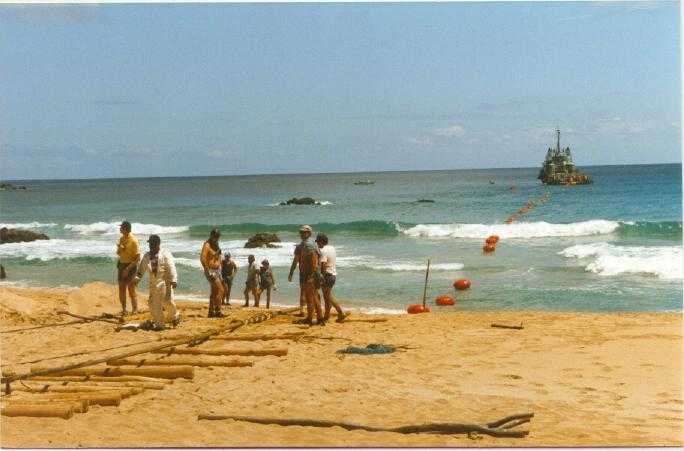
 |
|
|
 ANZCAN Segment A Repair, Norfolk Island, 1991 Telstra is one of the world's largest owners of submarine telecommunications cables and with around 95 percent of Australia's international traffic carried on cable, it is essential that submarine cables be protected against man-made and natural hazards which can interrupt international voice and data services. Telstra's increasingly important international business is supported by highly specialised activities in Network and Technology Group relating to the planning, installation, operation and ongoing protection of Telstra's submarine cables. "Telstra has invested many hundreds of millions of dollars in global submarine cable systems so protecting these cables from damage is of paramount importance," said Geoff Parr, Manager of International Networks and Technology, Core Network Development, ISW. "Cable protection work starts early in the planning phase, well before we lay the system on the ocean bed." With submarine cable links of up to 7,000 kilometres in length placed at depths reaching 8,000 metres, a key to ensuring long cable life starts with carefully matching cable design to the environmental conditions. The next critical step is to accurately lay the cable along the chosen route and for this, Telstra uses highly specialised and sophisticated installation tools and cable laying ships. "Whilst cable design and cable laying techniques will continue to be refined, our biggest immediate challenge is protecting the cable against man-made and natural hazards," Geoff said. "Fishing activity, particularly with towed trawls and dredges, is the greatest threat to the world's cable systems. Other threats to cable security are ship's anchors, undersea exploration activities and abrasion caused by cable movement on the sea bed." Geoff's group works closely with the Australian commercial fishing industry to prevent cable damage. "We liaise directly with commercial fishermen, marine training institutions and government departments responsible for managing the fishing industry in order to educate everyone about location of submarine cables, why they should avoid them and what action should be taken if fishing gear becomes entangled in a cable. We also provide the Royal Australian Navy with the latest cable location data to include on charts fishermen use and we ensure the land sections of Australia's submarine cables are fully integrated with Telstra's 'Dial Before You Dig' program. "Despite this ongoing effort, there is an ever increasing threat to cable systems from commercial fishing operations as diminishing fish stocks and quotas force fishermen to new fishing grounds, often in water depths of up to 1800 metres," Geoff said. An important cable protection activity which occurs off the NSW coast around Sydney is the operation of a full time submarine cable surveillance patrol boat. "Sydney has a large concentration of submarine cables landing at Bondi and Narrabeen and these cables traverse commercial fishing regions and major shipping lanes. The patrol vessel is equipped with state of the art auto tracking radar, a differential Global Positioning Satellite navigation system and other sophisticated equipment to assist in locating, tracking and identifying vessels which may be a threat to cable security. "The prime purpose of the patrol boat is to educate fishermen about cable location, not to stop them fishing around the cables. This operation has been so successful at protecting Telstra's cables that Korea Telecom has implemented a similar operation and British Telecom is investigating the merits of a patrol boat operation in the North Sea," explained Geoff. Another method used to increase cable protection is to bury the cable in the seabed wherever practicable, out to a depth of 2,000 metres. "We use a sea plough to dig a trench into which the cable is laid. The plough is effective to about 1500 metres water depth and after that, we use remotely operated vehicles to cut a trench using either a high pressure water jet or a rock saw. In places where it is too hard to trench, we use rock placement to cover the cable. This technique is used to protect unburied areas of the PacRimWest Cable off Sydney," Geoff said. "However, cable burial is expensive and is only viable where the seabed is geologically suitable.." Submarine cable protection is a global concern and all major international submarine cable owners and operators participate in the International Cable Protection Committee (ICPC). Australia's prominence in this Committee is evidenced by the fact that Geoff Parr has been unanimously elected Chairman of the ICPC for a three year term. "There are more than 70 members of the ICPC including all the world's major cable owners and operators. The Committee's prime purpose is to develop procedures and initiatives that protect submarine cables against man-made and natural hazards. "We share our cable protection role with many national and international groups and partners. Everyone has a similar objective, that is to protect the major investment we all have in submarine cables," Geoff concluded. (Reprinted from NTG Directions, Vol 4, No. 3 August, 1999) |
Send mail to Ron Beckett with questions or comments about this web site.
Last Modified: 30-11-2000
© Telstra Corporation Limited 2000
® Registered Trademark of Telstra Corporation Limited.